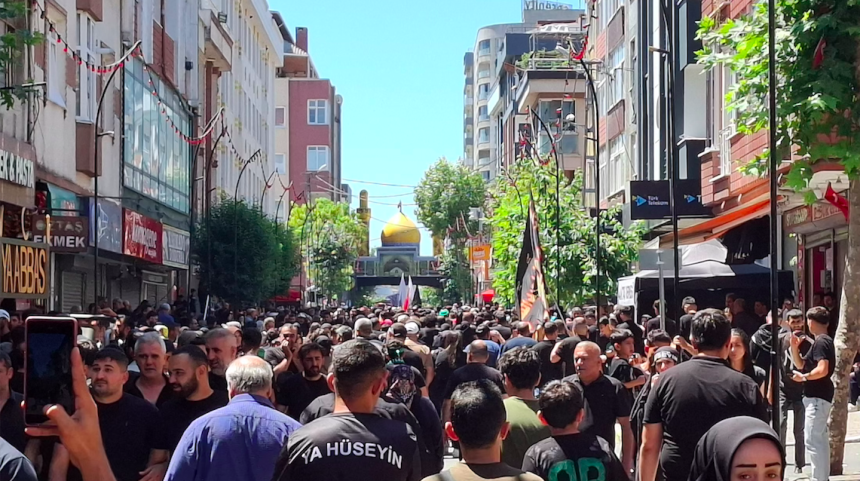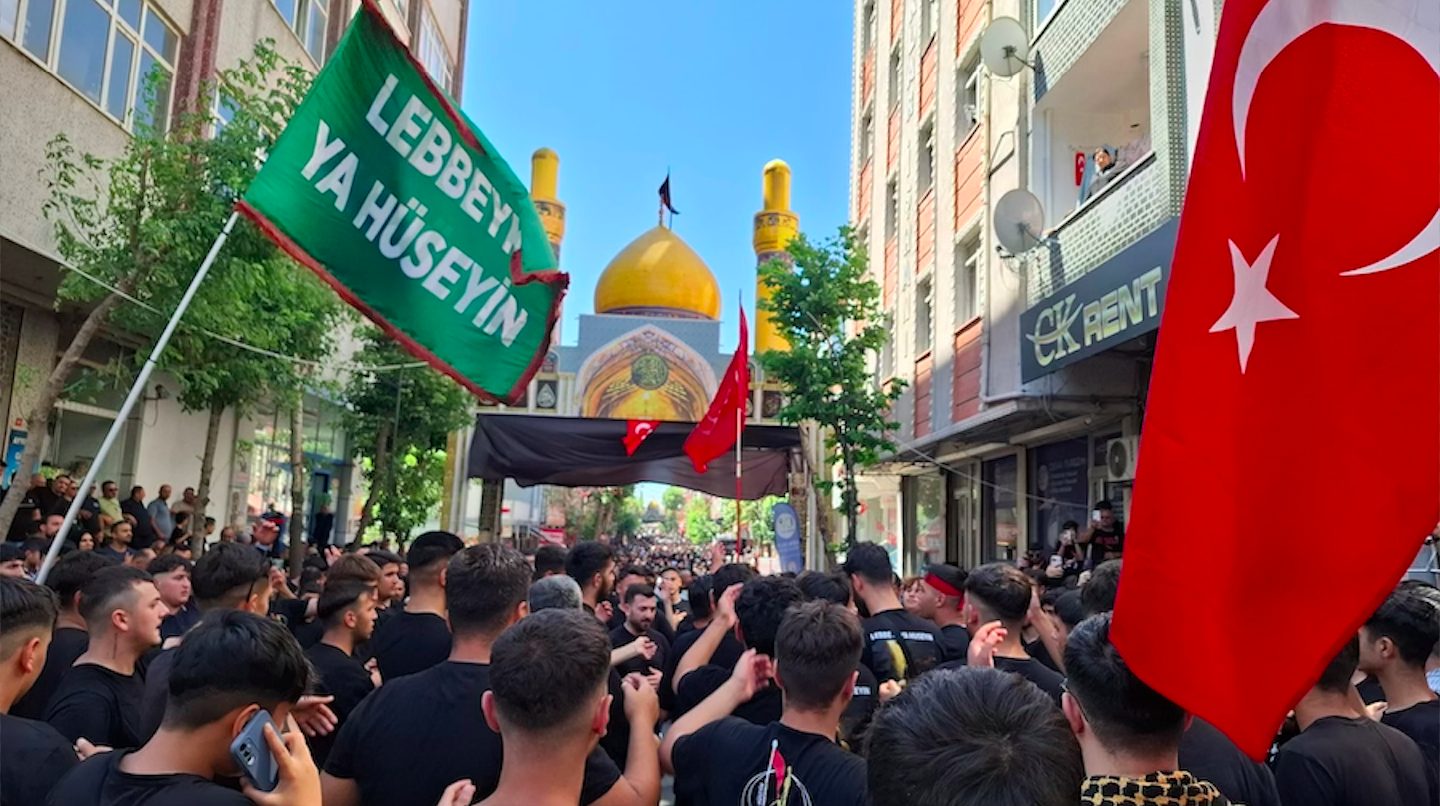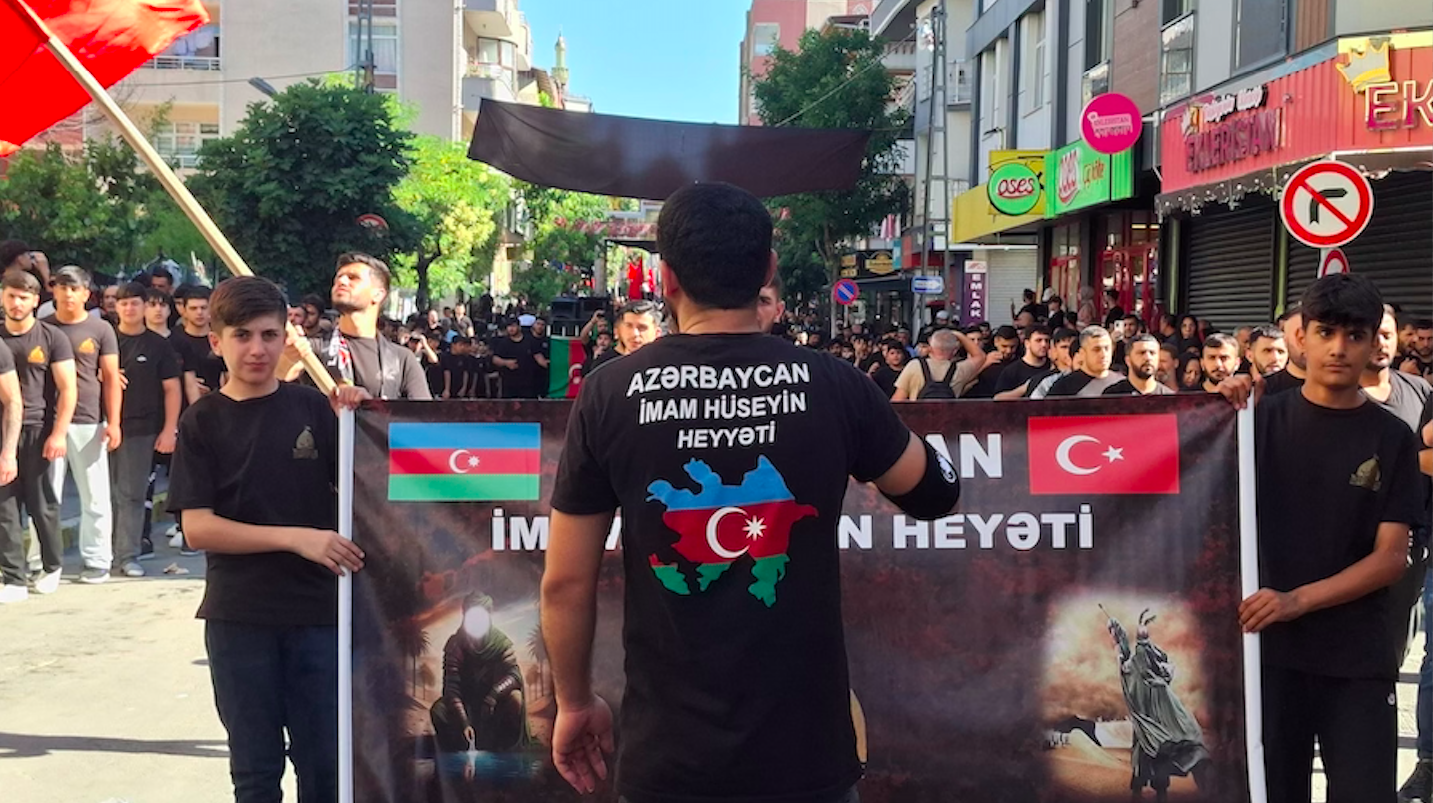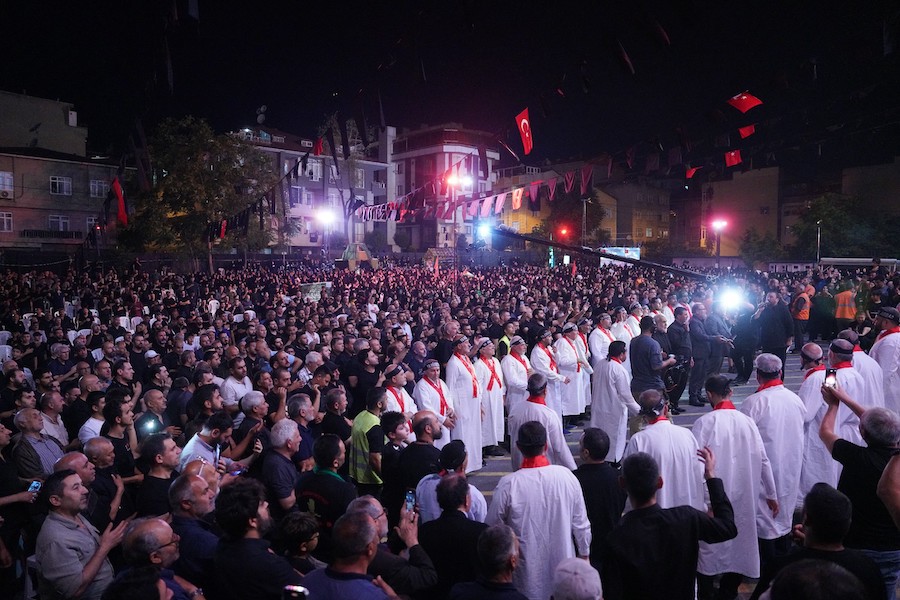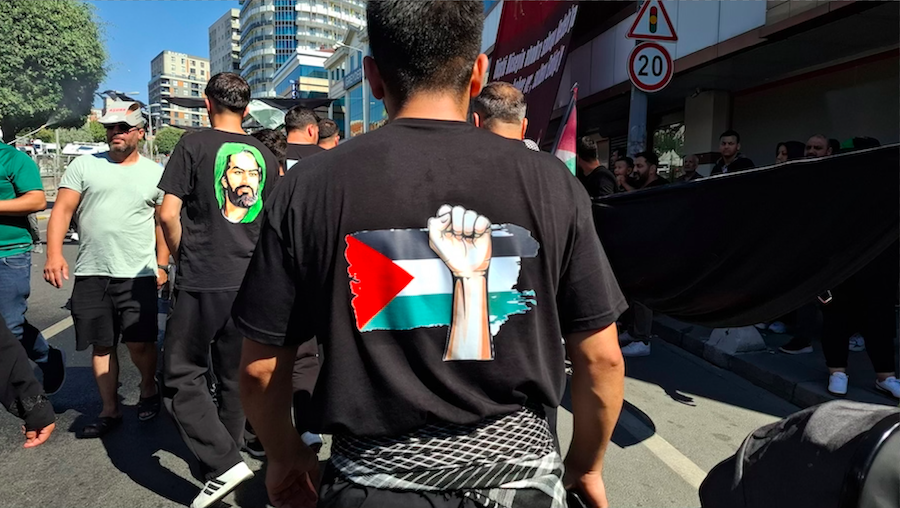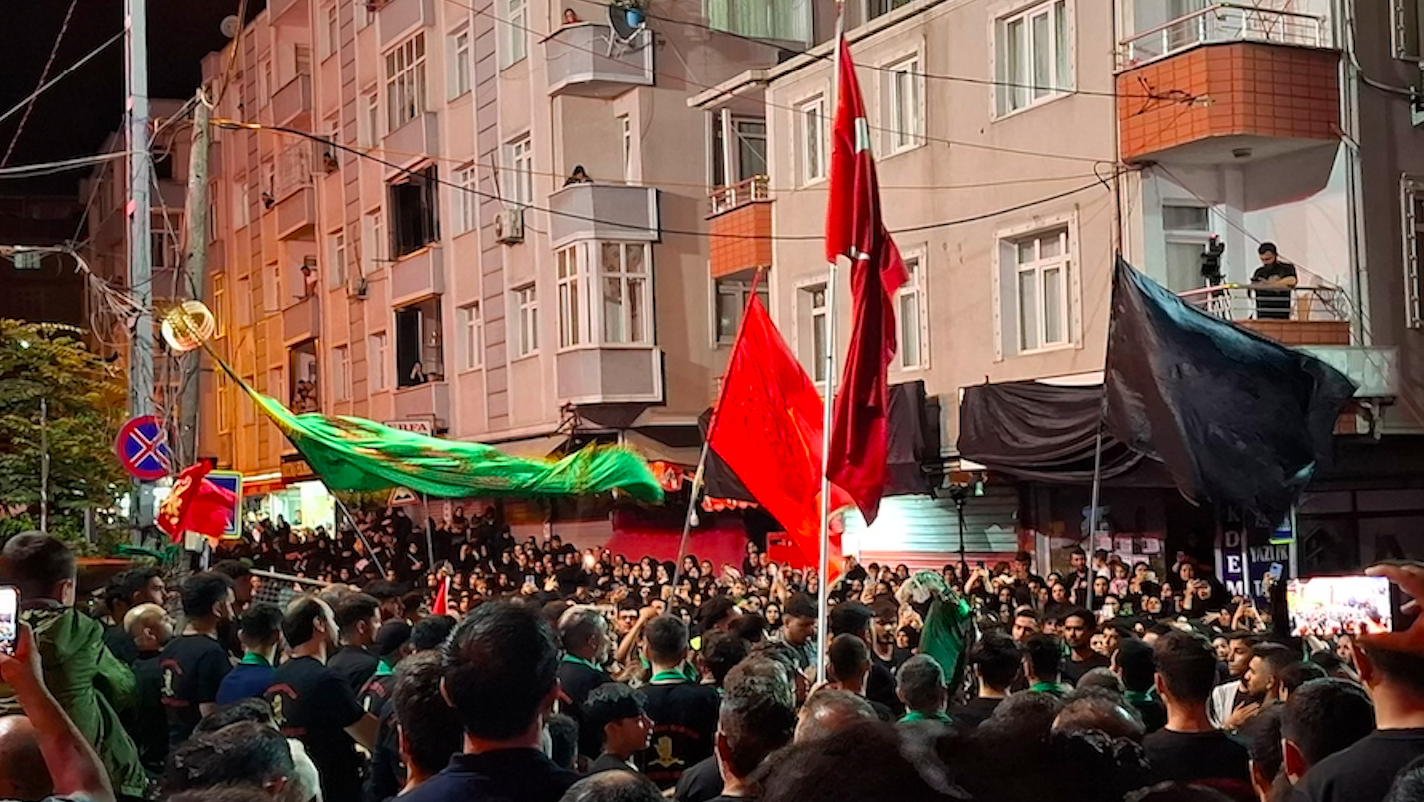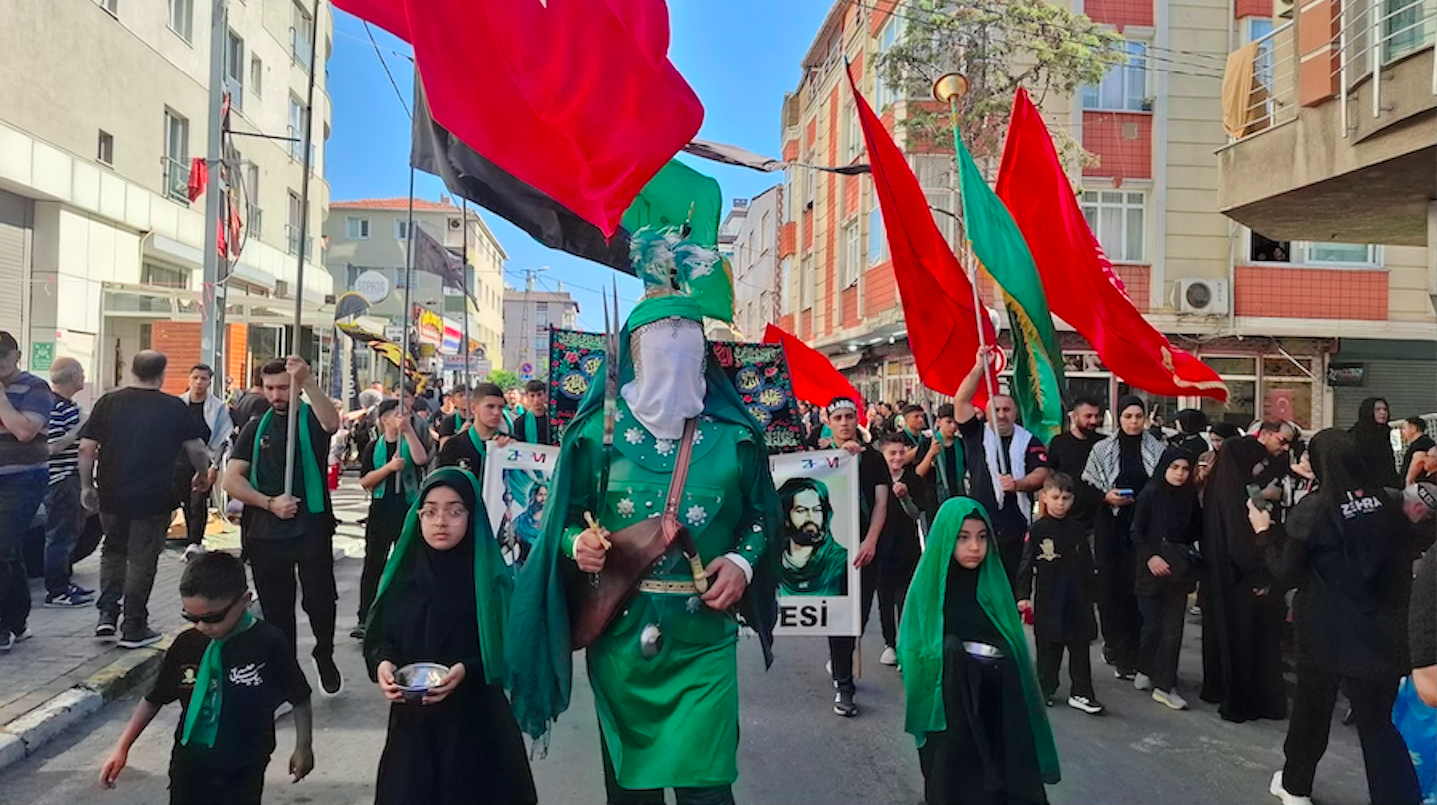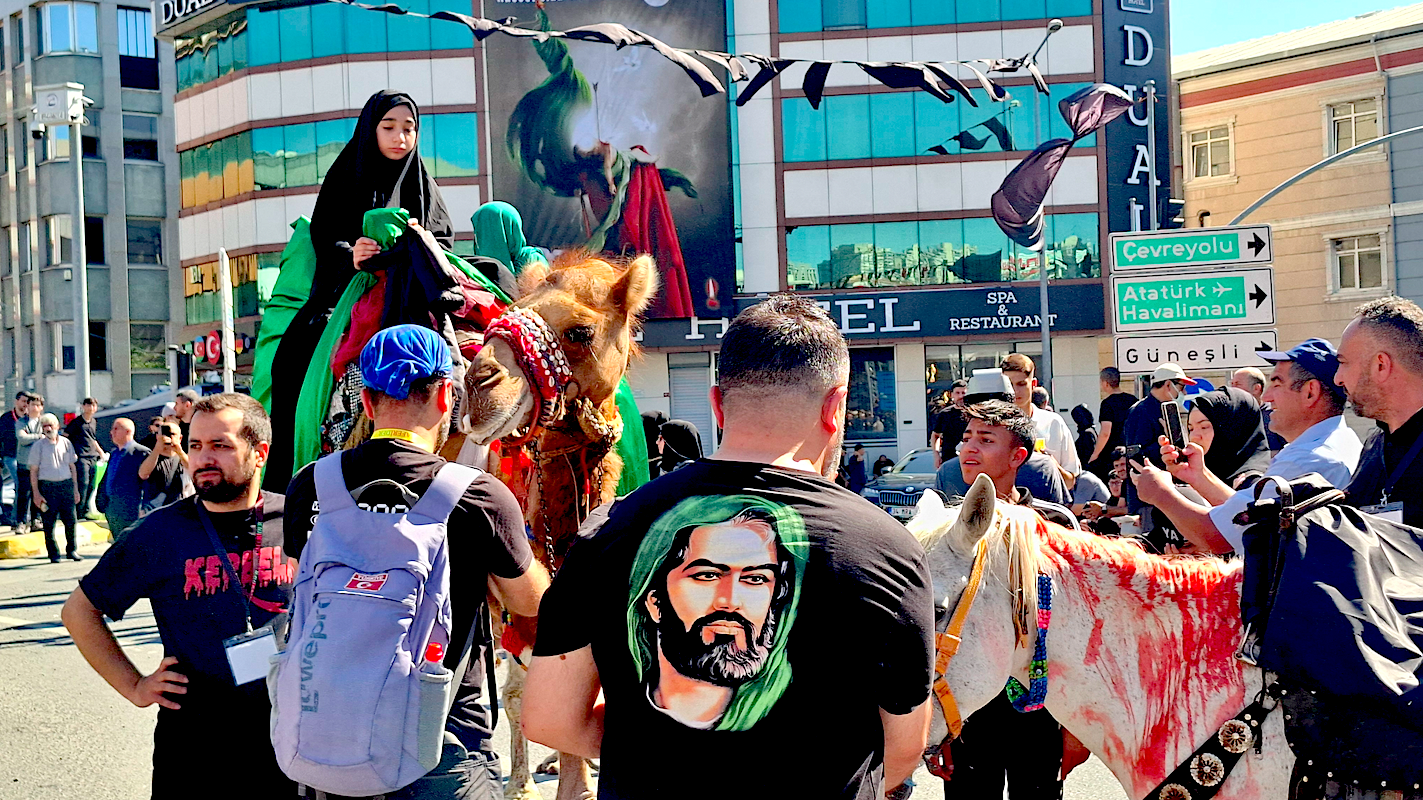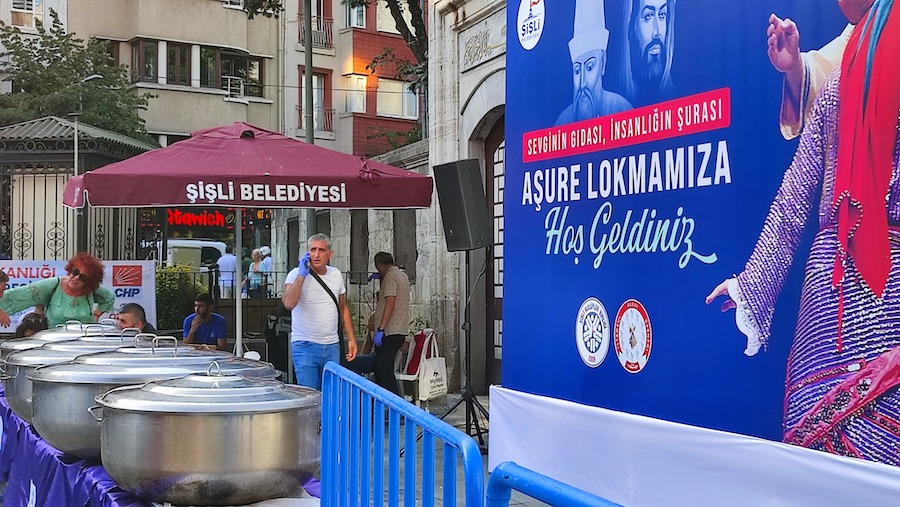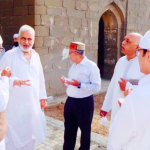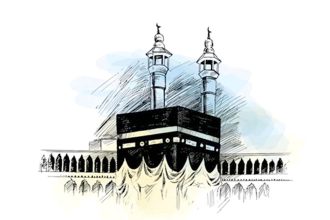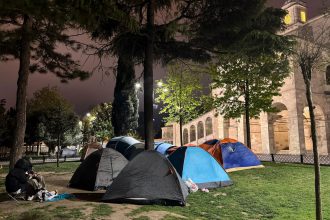It’s around nine in the morning on the tenth of Muharram—the Day of Ashura. I’m walking through the streets of Istanbul with my friend Ishtikhar Ali, who has flown in from Germany, all the way from India originally, just to be here. We’re heading toward the Zeynebiye Mosque and Cultural Center, near Halkalı Merkez, drawn by the quiet intensity that surrounds this day.
The streets are mostly empty at first. But only a few steps in, the silence begins to shift. From every direction, people start to appear—men, women, and children, all dressed in black, moving with a sense of shared purpose. Black flags ripple in the breeze, banners bearing the name of Imam Hussain (AS) and the standards of Hazrat Abbas (AS) flutter above us like sacred emblems. There’s a stillness to the air, but it’s filled with meaning. The entire atmosphere is drenched in mourning.
We soon find ourselves among crowds of mourners. The steady rhythm of sina-zani—chest-beating—echoes all around, as if each beat of the hand is recalling a heartbeat lost at Karbala. It feels less like a ritual and more like a reliving of grief, a collective memory passed down through centuries. And it’s not just people from Türkiye. Mourners from many nations are here, bound by a shared sorrow.
Among them, the presence of hundreds from Azerbaijan is especially striking. They’ve come in an organized procession of their own, marching with discipline and unity. One by one, mourning processions from across Istanbul make their way toward a single destination: the Yahya Kemal Beyatlı Performing Arts Center, near Aşura Meydanı in Halkalı Merkez Mahallesi.
By the time we arrive, the auditorium is overflowing. Not a single seat—or even a space to stand—remains. Outside, large screens have been set up to accommodate the crowds, and people gather quietly in front of them. The air pulses with the repeated cry of “Labbaik Ya Hussain”—”Here I am, O Hussain.” It rises from every direction, a chorus of loyalty and love. Around us, the atmosphere is charged—not just with grief, but with devotion, solidarity, and a deep, unwavering reverence for Imam Hussain (AS).
We had seen a similar scene unfold the night before, on the 9th of Muharram. The difference was in the mode and mood of arrival—people came in their cars, flags waving from windows and rooftops. They parked around Aşura Meydanı, then joined separate mourning processions that slowly made their way toward the Zeynebiye Mosque, performing chest-beating as they walked. Each procession eventually ended at the mosque, where the atmosphere was heavy with remembrance and reverence.
On the 10th, however, the destination was different. Instead of heading to the mosque, mourners were gathering directly at Aşura Meydanı, the heart of the day’s commemorations.
Behind the mosque, a majlis—a mourning assembly featuring recitations and sermons—was also taking place. It had begun on the very first day of Muharram and continued without pause, adding a spiritual rhythm to the entire ten-day period.
What stood out most, perhaps, was the powerful sense of community service. Blood donation camps had been set up, and people were coming forward in large numbers to donate. At the same time, the Küçükçekmece Municipality had arranged for medical teams and doctors to remain on-site, moving quietly among the crowd to assist anyone in need. It was a thoughtful gesture that ensured the health and safety of all participants during this emotionally and physically intense day.
What’s most noteworthy is that both Shia and Sunni Muslims in Türkiye participate in these mourning processions. In fact, this tradition has deep historical roots in the region. Maulana Shibli Nomani also mentioned it in his travelogue Safar Nama-e-Room-o-Misr-o-Shaam, published in 1894. He wrote, “The Muharram of this place is also something worth mentioning. I was very happy at the fact that Turks generally participate in these assemblies with decorum and sincerity. So much so that the sermon that takes place, except for one or two occasions, in all other assemblies, takes place in Turkish in consideration of the Turks.”
Today, I witnessed this age-old tradition with my own eyes. What moved me especially was how local people had set up food and water stations along the route for the mourners. Since the weather was hot, cool mist was being sprayed from machines onto the crowds. What made it special was the fragrance mixed into the mist, which left people feeling refreshed and cared for.
Just then, a memory from the past surfaced—from the year 2023. That year, Ashura fell on a Friday. I had gone to offer Friday prayers at a mosque, and outside, I noticed several buses parked, filled with people from different parts of the city. These were all government-provided buses, made available free of charge to help people attend the commemorations.
As soon as the prayer concluded, a mourning procession passed near the mosque. People stepped out, embracing the mourners, some even joining them in their chest-beating rituals. They had also arranged drinking water for the mourners—a small but profound gesture of unity, compassion, and respect.
What Is the History of Ashura in Istanbul?
The observance of Ashura in Istanbul has a very old and rich history. The renowned Indian scholar Maulana Shibli Nomani visited Istanbul in 1892 and witnessed the mourning ceremonies held during the month of Muharram in the Valide Han area (which is now part of Istanbul’s Fatih District). In his travelogue, he wrote, “In the assemblies here, there is no tradition of soz and taht al-lafz; only narration takes place. And in truth this alone is the purpose of the assembly of mourning.”
However, through my own research, I found that Iranians in Istanbul once practiced self-flagellation with chains as part of the mourning rituals. But this tradition faced restrictions later on.
On August 29, 1926, a report published in the newspaper Hamdard—edited by Mohammad Ali Jauhar and known for translating and publishing news about the Muslim world, especially Türkiye, from Turkish and Arabic sources—stated the following:
“As usual, the Iranians in Valide Han and Üsküdar observed the rituals of Muharram. On the 10th of Muharram, in anticipation of heavy crowds and to avoid any untoward incidents, the police made the necessary arrangements. The Iranians performed the traditional chain-beating as in previous years. However, that year, the government prohibited the practice of injuring their heads with knives or clubs and striking their chests with chains. The Iranian Ambassador, Tabatabai Efendi [Seyed Mohammad Sadegh Tabatabaei], also advised the Iranian community to abandon such practices.”
The renowned turkish historian Abdülkadir Yeler writes that Istanbul began attracting the interest of Iranian merchants in the 17th century, largely due to its strategic position as a bridge between Asia and Europe. This growing interest eventually led many Iranian traders to settle in Istanbul, particularly after the 18th century.
When it comes to mourning rituals during Muharram, by the second half of the 19th century, Noha (lamentation) recitations were commonly held at two primary locations: the Valide Han Mosque and the Seyyit Ahmet Deresi Mosque, located within the Karaca Ahmet Cemetery in Üsküdar. At that time, both of these mosques were recognized as centers of the Jafari (Shia) community.
According to historical records, these mourning gatherings were often loud and intense. Shedding blood in grief over the martyrdom of Imam Hussain, along with the recitation of elegies, were central elements of these rituals.
According to Abdülkadir Yeler, as the Jafari community gradually grew in Istanbul, by the late 1970s, they began the construction of their own mosque, named Zeynebiyye, which was officially opened for worship in 1981. After the mosque opened, many Jafaris living in other parts of Istanbul relocated to Halkalı, which then became the district with the highest concentration of Jafaris in the city. Over time, the Zeynebiyye Mosque evolved into the most important Jafari center in Istanbul.
Today, Zeynebiyye Camii remains the largest and most prominent center for the Jafari community in Istanbul.
Please note that the mourning processions on the occasion of Ashura are held not only in Istanbul but also in other cities across Türkiye. Among these, the cities of Kars and Iğdır in Eastern Anatolia are particularly noteworthy.
Another Old Tradition
Here, people observe fasting on the Day of Ashura, and the government arranges communal iftar meals at various locations, where both Shia and Sunni communities come together.
Another longstanding tradition is the distribution of ‘Aşure’ after iftar. This is a traditional Turkish sweet dish that people share with friends, relatives, neighbors, colleagues, and classmates during the month of Muharram—without any religious distinction—as a symbol of love and peace. Both Shia and Sunni communities actively participate in this practice.
One of our neighbors kindly remembered us as well, and just like previous years, we received Aşure at our home this year too.
One of our friends explains that preparing Aşure takes a considerable amount of time and can be quite costly because it is made primarily from dried fruits. It is also very beneficial for health. It provides protein support for vegetarians and is helpful for people with heart and eye conditions.
This tradition has been maintained for nearly five centuries, dating back to the Ottoman Empire. According to a report, Aşure is also called “Noah’s Pudding.” Turkish tradition holds that it was first prepared by Prophet Noah (Nuh, AS) himself, which is why it carries this name.
The story goes that when Prophet Noah’s Ark came to rest on Mount Judi on the 10th of Muharram, most of their food supplies had run out. Noah instructed his family to gather whatever remaining ingredients they had on the Ark and mix them together to create this sweet pudding.
It is noteworthy that it was on the Day of Ashura that Prophet Noah and his family finally left the Ark, marking a joyful occasion. Since then, Muslims in Türkiye commemorate this day by distributing Aşure among neighbors as a reminder of their escape from the Ark.
While various municipalities also distribute Aşure to the public, this practice continues throughout the month of Muharram until its last day.
Afroz Alam Sahil is a journalist and author. He can be contacted at @afrozsahil on X.

